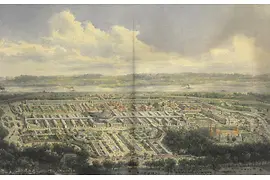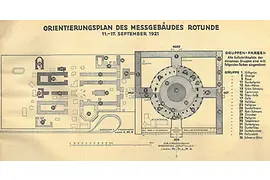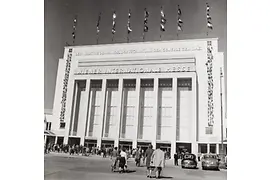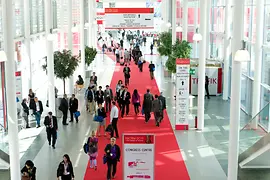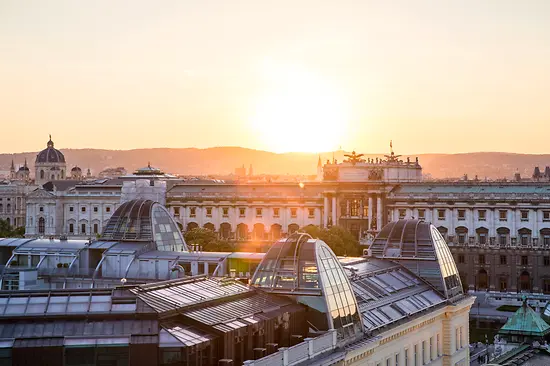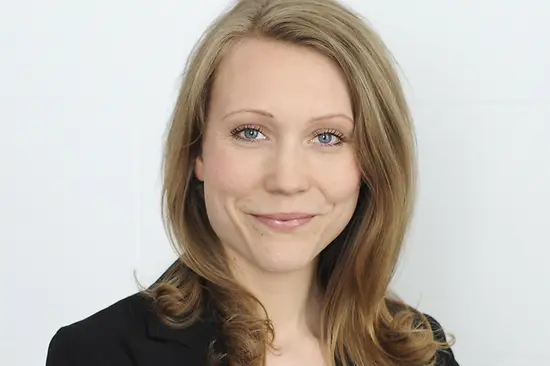100 Years of Messe Wien: a success story
A 15-hectare site with 55,000 m² of exhibition space, capacity for 25,000 visitors, and separate conference center complete with a cutting-edge office tower: Messe Wien Exhibition & Congress Center is one of the core locations comprised by Meeting Destination Vienna. Each year, hundreds of thousands of participants flock to the site. A tale of success that started exactly 100 years ago, with a fascinating back story to go with it.
You can see a documentary about 100 years of Messe Wien here.
The back story: the world's largest dome
The foundations of what would eventually become Messe Wien were laid in 1873, when the Austrian capital became the first city in the German-speaking countries to host the World Expo. In preparation for this monumental international event, a gigantic exhibition space was built in the Prater park with the legendary Rotunde building at its heart: towering some 84 meters above the ground and spanning 108 meters, it featured the largest dome in the world at the time. The superlatives associated with this record-setting space also extended to the exhibits on display inside. After the World Expo, the area continued to showcase the latest breakthroughs, pioneering ideas and examples of progressive thinking. Anyone wanting to see what the future had in store would end up at the venue in the Prater sooner or later. Particularly in 1883, when it hosted the International Electrical Exhibition, a pioneering event designed to show the public the new possibilities opened up by the medium of electricity. The first International Ornithological Congress (1884) and the first World Congress of the International Union of Forest Research Organizations (1893) were also hosted here. Thanks to the Congress of Vienna of 1814 and 1815, Vienna already had an outstanding reputation as an established congress destination.
The early years: upturn and major fire
It stood to reason that the area would retain its focus on fairs and exhibitions after fall of the monarchy and the end of the First World War. In the late 1920s, the fair and exhibitions committee was reconstituted. The official formation of Wiener Messe in its present-day guise came in fall 1921 with the first Wiener Internationale Messe. The Rotunde building was also adapted to reflect the new circumstances. Vienna was a proud exhibition destination once again. But 1937 brought catastrophe. A devastating fire razed the Rotunde to the ground. A new south hall was erected under the Nazi regime, complete with monolithic south portal. During the Second World War, autumn fairs were held at the site each year.
The post-war years: reconstruction and new structures
After the Second World War, life in Vienna was dominated by reconstruction. The exhibition and fairground site was largely destroyed in bombing raids. Despite the widespread damage to the site, the first Wiener Messe of the post-war period opened in fall 1946. This laid the foundation for the reintroduction of the popular spring and fall fairs, which continued to take place all the way into the 1970s. With structures and demand patterns starting to shift, the public fairs were gradually replaced by trade-only and special temporary events. And Wiener Messe was privatized.
At the turn of the millennium, the location's appeal started to reach new heights once again. Having re-acquired Wiener Messe AG in 2000, the City of Vienna set about creating a contemporary, ultramodern trade fair venue on the site. The new fair and congress center was created by the renowned Viennese architect Gustav Peichl, who gave the ensemble a distinctive look through the addition of the new Messeturm tower and the flowing lines of the conference center.
A successful present
The new Messe Wien Exhibition Congress Center opened at the start of 2004. In 2001, Reed Exhibitions took over as the exclusive operator of the site. Reed Exhibitions has operations in more than 40 countries, making it the world’s second large fair organizer. The transfer of responsibility triggered a wave of important developments for Meeting Destination Vienna, such as bringing the annual congress of the European Society of Cardiology – Europe’s largest medical congress – to the capital in 2007, when more than 22,000 participants and 5,600 exhibitors converged on the city. A year earlier, Messe Wien Exhibition & Congress Center hosted the Latin America Summit during Austria’s rotating Presidency of the Council of the European Union. One of the more recent highlights came in 2018 with the 36th Congress of the European Society of Cataract and Refractive Surgeons (ESCRS), which played out at the venue in parallel with two other events (EURETINA – European Society of Retina Specialists and EuCornea – European Society of Cornea & Ocular Surface Disease Specialists), attracting a total of around 19,000 participants. Other well-known and established fairs include Ferienmesse, Bauen + Wohnen, Hohe Jagd & Fischerei and Alles für den Gast. Another factor behind the venue’s success was added in 2008 when Messe Wien Exhibition & Congress Center got its very own stop on the newly expanded U2 subway line.
Pandemic sparks fresh approaches
The site reaffirmed its status as an essential element of the capital's infrastructure once again during the pandemic. In 2020, Messe Wien Exhibition & Congress Center was transformed into a medical care facility comprising testing and vaccination lanes. The shift from in-person towards online and hybrid events as a result of the pandemic led to the creation of additional digital concepts in 2020 and the installation of a state-of-the art broadcasting studio for congresses and meetings. Messe Wien subsidiary STANDout also offers virtual site visits for organizers looking to host events at the Messe Wien Exhibition & Congress Center. Accompanied online by the Messe Wien team, the halls and spaces can be reconfigured in real time to show a range of seating layouts and individual settings.

